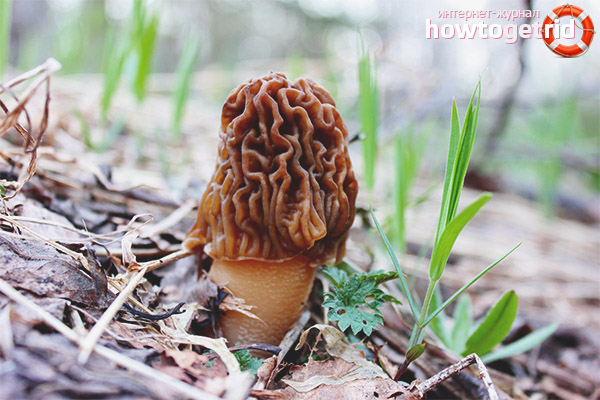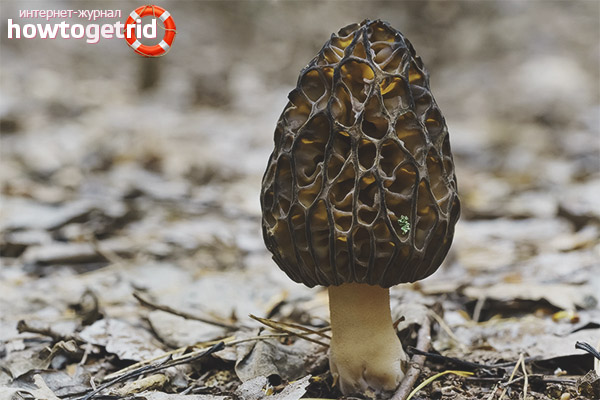The content of the article
The mushroom family lives in larches, as well as a mixed strip. These representatives of the species appear quite early, everything depends on the growing area and climatic conditions. By morels are meant rather large specimens, which are ranked as a morel family. It is very difficult to find at least a couple of mushrooms, since they are cleverly disguised due to their specific coloring. Today we look at everything that affects morels, we will study the subtleties of growth and species.
Description
- Under the ordinary morel means a mushroom of large overall characteristics. He is similar to other members of his family, lives among the foliage, so it is difficult to gather. Only experienced lovers of quiet hunting in the power to find copies.
- By its dimensional features, the fruit body can grow up to 17 cm.and more. The tip of the format of the egg or ball, pigmented brown or brown-yellow shade. It may be oval, flattened, but it is rather an exception to the rule. With the passage of life, the mushroom darkens, the edges of its tops attach to the base and grow.
- The hat is about 5 cm in diameter, with an average height of 8 cm. The surface is wrinkled, covered with mesh-cells with irregularly shaped cells. All openings are separated by narrow partitions, pigmented in beige or white.
- The base in the form of a cylinder, closer to the ground compacted, painted white. The older a particular instance, the darker its color. The leg can reach yellow or brownish beige. Fruit bodies that are ripe enough have a brownish pigment. Sometimes the base is covered with whitish flakes.
- Reproduction is carried out by means of spores, which have an elliptical shape. Their surface is smooth, but may be granulated. Spores are stained with yellow or brownish-white pigment. Spore proliferation is carried out in bags, which are otherwise called ascs. They are at the top of the hat and are lined with a thin layer.Aski are also cylinder-shaped, as is the base.
- As for the soft part, it is pigmented with a light tone. That is, it can be creamy, whitish, ocher-white, as well as with light yellowness and fading. The flesh is tender and fragile, it quickly cracks, breaks easily and loses its original appearance.
- Now it's time to consider the taste and flavor of this mushroom representative. The thing is that it almost does not stand out by its smell, and its taste is rather pleasant. However, to consume in raw form is not recommended, because there is a certain amount of poisons.
Spread
- Edible fruit bodies most often prefer to grow in the temperate zone. Copies are found in the Northern Hemisphere. Morel populations are found from Eurasia and extend to Japan. Also, mushroom pickers often collect such fruit bodies in Australia, North America and Tasmania.
- Mushrooms in most cases grow alone, although sometimes small groups are found. Copies prefer to grow in well-lit areas.In addition, the soil should be quite fertile and rich. Morels grow in coniferous and mixed forests.
- Specimens can grow without problems in parks and apple orchards. Mushrooms are found on clearings, forest edges, glades, near fallen trees and near water channels and rivers. On the territory of the Russian Federation such fruit bodies are often found in gardens, orchards and lawns.
- Morels love to grow in landfills and old fire places. If autumn is warm enough and long, then fruit bodies grow without problems until the end of October. However, this phenomenon is considered to be quite rare. Still, specimens refer to spring mushrooms.
Toxicity and cultivation
- In the considered fruits and similar lines there is a dangerous substance in the form of giromitrin. However, in morels such a harmful compound is contained in much lower concentrations. Studies have shown that, depending on the region of growth, there is no such toxin in the specimens discussed.
- In any case, before consumption in food fruit bodies must be subjected to heat treatment. After that, the water should be drained.If you do everything right, then you will enjoy the meal exclusively. In this case, no harm to the body will not be applied.
- Some summer residents in a year at the end of April, whole colonies of morels grow under large apple trees. This is not surprising, fruit bodies can be bred artificially. There is enough information about this if you want to do this.
- In short, there are two ways of self-cultivation of mushrooms. The German method implies that one type of morel is bred in a garden or forest. After that, sow pieces of fruit. Next they need to fall asleep. In general, there is nothing difficult in such a technology for removing specimens.
- There is also a way of French breeding. In this case, more often morels appear immediately in large groups. The bottom line is that the fallen apples do not need to collect, they must rot. Before this, you need to sprinkle pieces of fruit bodies. As a result, you simply cover the mushrooms with compost decomposed. For winter, the fruit should be covered with foliage. In early spring they need to be cleaned.
Edibility
- As mentioned earlier, the fruit bodies under discussion are edible, but belong to the 3 categories of conditionally edible mushrooms. Fruits enough to boil in boiling water a quarter of an hour, the field of which the broth must be drained.
- Further morels can be prepared in any way convenient for you. You can fry or boil them. If you are going to dry them, then pre-boiling is not required. However, the drying process should be quite long.
Morel conical
- This mushroom copy is much more enduring than the previous one. He lives in a humid environment, may be in the shade. The inner part is hollow, the foot grows together with the top, which is pigmented with a gray-brown or pure brown color. Over time, the hat gets a different color - brownish.
- According to its width, it can grow up to a maximum of 5 cm, but it is stretched to a height of 10 cm and even more. From the name it can be understood that the tip is conical in format, elongated upwards, cells have an irregular shape and dark tone partitions. The soft part is like a wax, there is a light mushroom flavor, typical of this species.
- As for the leg, it is rather thin in diameter, it grows only up to 2 cm.They are about the same in height (up to 5 cm. Maximum). The base of the cylinder, there is fragility and yellowness in color. The leg is smooth, it can be slightly curved due to its fine structure. The bottom is narrowed or, on the contrary, extended. As for taste, they are ordinary.
Verpa edible
- Another species of the family is from the family. This representative grows in larch trees, likes to be located next to aspens. On coloring yellowish with brown or purely brown.
- The hat is about 3 cm in diameter, the base is stretched up to 2 cm. The hat's height is large, the format is elongated, the length itself is about 10 cm, but it can reach up to 14 cm. The leg has a yellow-white or white tone.
- The top is shaped like a bell, its surface has folds, and the edges are famous for their tortuosity. The hat is attached to the base, but this is only in the middle section. The edges do not grow together, which is not typical for these specimens.
- The leg can be smoothed, and is also famous for its light scales in some morels.The inner part is empty, however, in young stock it may resemble cotton wool. It does not smell very good, pretreatment is required, and quite a long one.
Fruit bodies also have a lot of useful qualities. Their composition is quite unique. With the systematic consumption of specimens increased visual acuity. In addition, the active compounds prevent the development of many diseases.
Video: morels and lines - errors and myths













To send